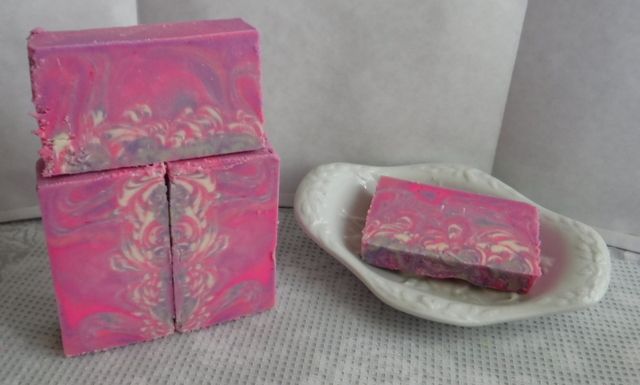To make a soapmaker's classic castile that lathers nicely, lasts a long time, and only requires a 4-6 week cure --> use 100% olive oil, whatever lye solution concentration you prefer, the usual 5% superfat (lye discount), and a blend of 95% NaOH and 5% KOH (potassium hydroxide).
The KOH makes the soap more soluble in water. Thsi means the usual stringy oleic soap gel doesn't form as easily with a KOH-NaOH castile as it does with a castile made with NaOH only. I won't debate the "cure faster" issue -- all I will say is if you want to make a true castile (100% olive oil) and would like it to last a long enough time, make lots of nice lather, and be mild to the skin after a more typical 4-6 week cure, then try using the mixed lyes.
I really want to try this, but I am having a very hard time trying to adapt my [50% lye] masterbatch to say, a 40% lye concentration, particularly with the added KOH.
Using the advanced search I have been unable to find any answers to this question. It doesn't mean they are not here, but I just cannot find them.
I think I can do the calculations for a 40% concentration easily enough with just NaOH, but with a 5% KOH and 95% NaOH, how would I do this? I am at somewhat of a loss. Do I use the NaOH water and ignore the KOH water recommendations? Or is there a formula for figuring out how much water for the KOH separate from the amount needed for the NaOH, thus having to add the two together?
Well this is how far I have gotten so far:
95% NaOH for this 32 ounces of OO = 110.9 grams
5% KOH = 9.1 grams (per Soapee) Or is it 8.1 grams (I get 8.1 if I use the 0.713 number as the divisor in this post)
That's about as far as I get, because I don't know where to go with the water.
Soapee says to use 179.9 grams of water total. Okay, so if I do that, then here's what I will do with my 50% masterbatch:
221.8 grams of 50% Lye solution
69 grams of additional distilled water
9.1 grams of KOH (per Soapee) BUT other calculations lead me to 8.1 grams (1.403 as a multiplier or 0.713 as a divisor)
Both MMS & SummerBeeMeadow also come up with 8.1 grams KOH, so I am thinking 8.1 grams is correct and not the 9.1 I get in Soapee (or maybe that's because the KOH is set at 90% purity in Soapee?)
Which of these numbers correct for the KOH?
Is the additional water amount correct, and how does one determine that for a mixed lye soap?
~ ~ ~ ~
Also at one point I think I found a post where someone (don't remember who, but I think it was one of the more sciene-minded members) posted a little chart about how to figure out how much water to add to a 50% lye pre-mix (masterbatch) solution to come up with respective concentrations. I believe it listed them like for 40% add, for 35% add, like that. Anyway I can't find it now and I thought I bookmarked it. So perhaps it was my imagination.






